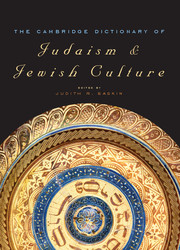Book contents
P
Published online by Cambridge University Press: 05 August 2014
Summary
Pale of Settlement refers to the area in the Russian Empire in which Jews were permitted to settle. This large swath of western *Russia, constituting just under 500,000 square miles, was officially called cherta postoiannogo zhitel'stava evreev. (The term “Pale” [an enclosure] was drawn from its use in depicting nineteenth-century Irish conditions.) The Russian Pale included fifteen provinces that were consolidated in imperial statutes from 1804 to 1835; these were subject to intermittent alterations until the Pale's effective abolition in 1915 and official dissolution with the Russian Revolution in February 1917. Jews made up some 12% of the population of the Pale; in many urban areas, especially in northern provinces in *Lithuania and *Belorussia, they made up the majority. Map 11
The Pale originated in 1792 after the first partition of *Poland in 1772. Merchants wary of competition and alleged Jewish economic mendacity protested the influx of Jews from Belorussia into Russia. Such sentiments had a continuing influence on the ongoing existence of the Pale; Russian officials who occasionally considered its abolition were persuaded that Jews would have a disruptive economic impact if permitted to settle more freely. The Pale restricted Jewish residence, roughly speaking, to those areas where they had lived before the Polish partitions (1772, 1793, 1795).
- Type
- Chapter
- Information
- The Cambridge Dictionary of Judaism and Jewish Culture , pp. 469 - 504Publisher: Cambridge University PressPrint publication year: 2011

